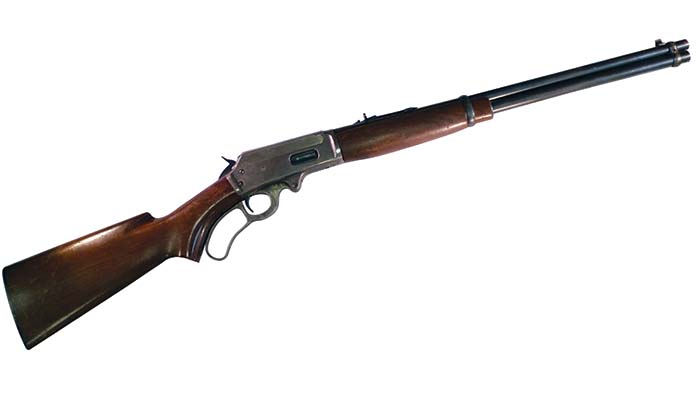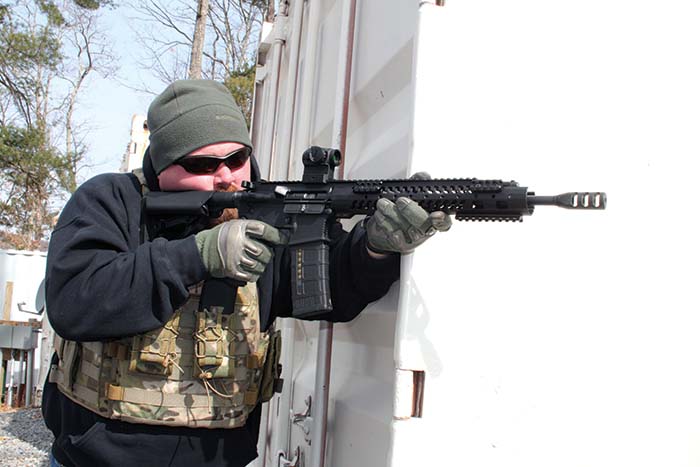A lever action rifle similar to this Marlin 30-30 would have been in the gun room of the Clark County Sheriff’s office when gambling was legalized in 1931. The Model 1893 was made from 1893 to 1936.
By Tom Murphy
1855 – 1899
The Early Years
Nevada Territory became our 36th state on October 31, 1864. Las Vegas is generally thought to have begun in 1905 when the Union Pacific Railroad began stopping at a site where there was water from a spring and an area for passengers to rest.
The sight was named Las Vegas (The Meadows) Springs for the three springs that ran into two pools of water. It’s said that American adventurers John C. Fremont and Kit Carson camped at the springs in 1844. By 1924 so much water had been used that the water table had dropped below the surface and the Las Vegas Land and Water Company drilled Well #1 in 1923.
The Mormons out of Salt Lake City established the first non-native American settlement near the springs in 1855. Due to hardship, high temperatures and problems with the local Paiute inhabitants, the 30 Mormon missionaries petitioned leader Brigham Young in Salt Lake City to be allowed to abandon the settlement and a fort that was under construction. They departed in 1857 and the settlement was left unattended.

During this time, prospectors had found their way to a remote canyon south of Las Vegas, near the route of current-day Hwy 95, where Spaniards had discovered silver back in 1775. The early Spanish miners built a small settlement at the canyon mouth where it drained into the Colorado River. They named it Eldorado (El Hombre Dorado – literally “The Man Golden”, or The Gold Man). Unfortunately for the Spaniard prospectors, they mined the silver, but completely missed the gold just under the ground.
The new miners began by sluicing the streams feeding into the Colorado River. Then the gold was found in the hills and times became interesting in Eldorado Canyon. They managed to keep the gold secret more or less, due to the remoteness of the discovery. However, this all changed in 1858 when paddle wheel steamboats made their way up to the remote encampment from Yuma, Arizona. Gold fever struck and in short order miners began to arrive and stake out claims on any available, or sometimes un-available, piece of dirt that looked like gold might be below.
By 1862 miners had discovered a vertical seam of gold and named it the Techatticup – a Paiute word for starving. Next up was the nearby Nelson District, where the Gettysburg, Duncan, Solar, Rand, and other mines were sunk. The area was to become the earliest and richest mining district in Nevada.

Many of the area’s inhabitants were deserters from the Civil War, gamblers, men on the run from serious crimes and other ne’er-do-wells. Their skill at extracting wealth from the ground wasn’t quite as good as their ability to extract wealth from people. Disputes grew into gunfights rapidly. Greed reared its ugly head. Claim jumping was commonplace, and vigilante justice was the only justice in this very remote area.
Mine ownership came to question. The Techatticup Mine was a case in point. At one time part of it was owned by Senator George Hearst, father of William Randolph Hearst of publishing fame. So much dispute, labor problems and bad management overshadowed the mine that it grew a dangerous reputation.
The killings in Eldorado Canyon, by that time with a population of nearly 500 people, became almost a daily matter. Regular law enforcement refused to patrol the canyon for fear of getting murdered.
The weapons the residents used to dispatch each other with great frequency ranged from whatever was close at hand, be it a pick, or some blunt object, to well-worn-but-serviceable black powder weapons for the most part. Commonly used firearms would include Civil War rifles like the Sharps New Model 1859 rifle as carried by Col. Hiram Berdan’s 1st and 2nd Regiments of U.S. Sharpshooters. Some guns came from the British Isles via Confederate deserters like the John Dixon and Son of Edinburgh, Scotland .577 sharpshooter rifle. Southern blockade runners brought these into South Carolina. The South had little or no gun making facilities and relied heavily on gunmakers in Great Britain for their weapons. Like other British gun makers, Dixon had been around since the 1820s and turned out shotguns and rifles.
Handguns would vary from pocket pistols like the Remington-Beals 1st Model Pocket Revolver built 1857-1858 to a Colt 2nd Model Dragoon Revolver manufactured around 1850-1851.
Prospectors weren’t the only killers. Eldorado Canyon had two of Nevada’s nastiest murderers who were Native Americans – Ahvote and his stepbrother Queho. Ahvote is said to have been responsible for five victims. Queho was a bit more active and is believed to have sent over 20 souls to the happy hunting ground; with the last being Maude Douglas whom he dispatched in 1919. Adding insult to injury, he then proceeded to successfully avoid all efforts of capture by various posses. His bones were located inside a cave near the Colorado River in 1940 by prospectors. They are now interred at Cathedral Canyon, NV, 40 miles Southwest of Las Vegas. Ahvote’s outcome? Hunted down by Queho and slain for the murder of some local residents.
1875
Kiel (Kyle) Ranch Killings
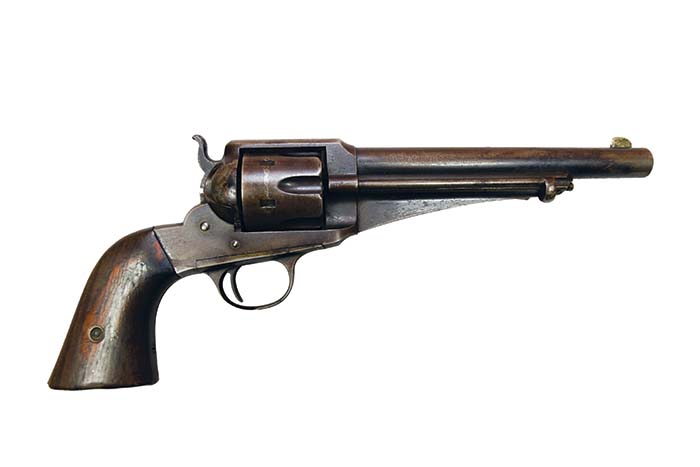
Running a ranch in the Las Vegas area back in the late 1800s was a back-breaking, thankless, arid job. Water was scarce, the alkaline soil wasn’t suitable for many crops, and feeding livestock on scrub brush made for very skinny cows and sheep.
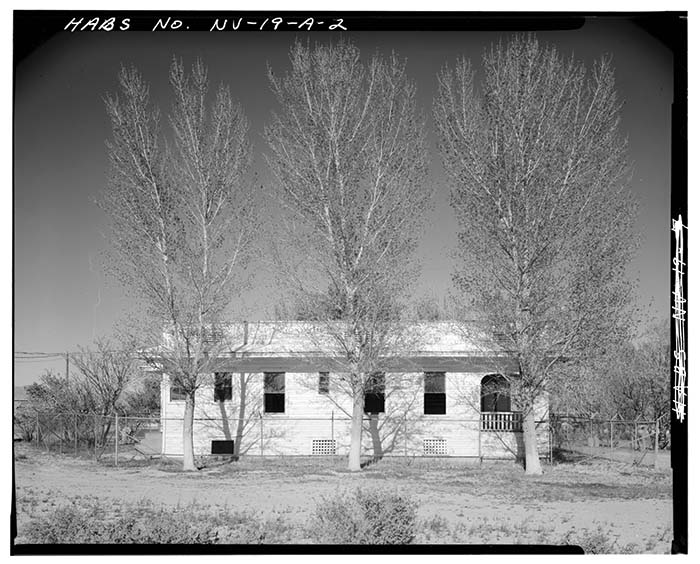
The Kyle Ranch was established by Conrad Kiel in 1875 near the corner of Losee St. and Carey Ave. in North Las Vegas. It had a well-earned reputation as a hideaway and shelter for some serious badmen like Jack Longstreet – a particularly nasty fellow. In his youth, he had an ear removed, probably not gently, for stealing a neighbor’s cattle. He hired on with the Tonopah Stage as a gunman – not as a stage guard. Thusly employed, he proceeded to kill his brother-in-law. Both his temper and his guns were deadly quick. He died from an accidental self-inflicted gunshot wound at 94 years of age.
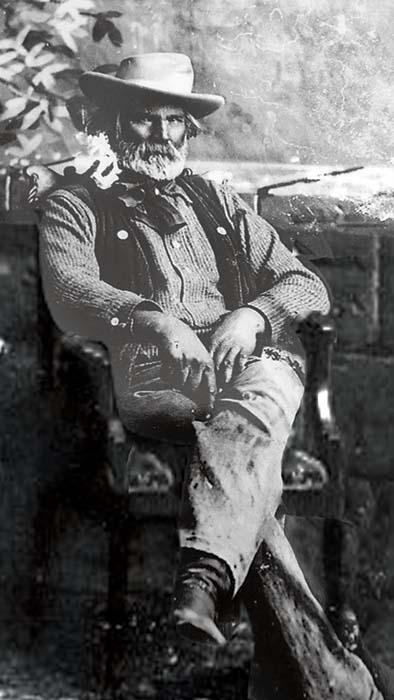
Then there was the killing of Archie Stewart at the Kyle Ranch in 1884. Archie owned the Las Vegas Ranch a few miles south of the Kyle Ranch. His wife, Helen, was in charge while Archie was down in Eldorado Canyon delivering produce and meat to hungry miners. While he was bouncing over rocks in his freight wagon many miles from home, one of his ranch hands, Schyler Henry, announced in fairly foul terms that he was quitting and wanted his wages. Helen Stewart said he’d have to wait for Archie to return. He replied threateningly in what she said was a “black-hearted slanderer’s tongue.”
Archie was tired from many hours in a stiffly sprung wagon, but after a short meal and a long drink, he saddled a horse and loaded his rifle (said to be a Winchester 30-30, a very popular gun for ranchers) and headed out to find Mr. Henry at the Kyle ranch.
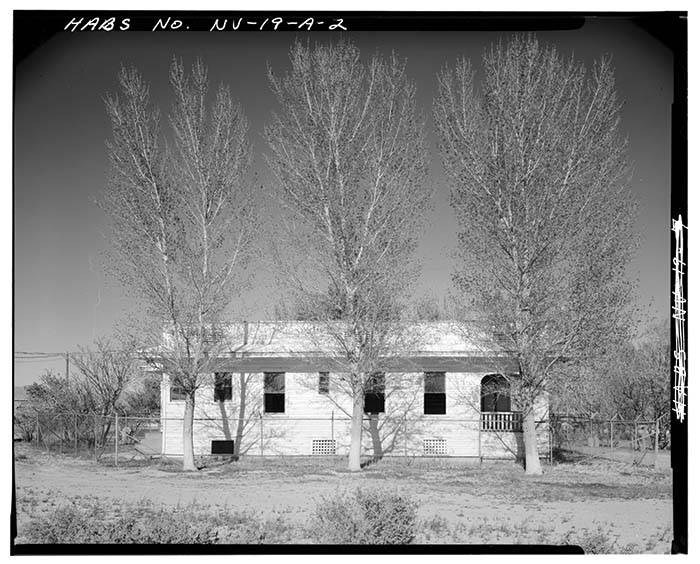
He arrived at the Kyle ranch house and proceeded to the back of the house, gun in hand. All the windows and doors were open. He was spotted and shot first – and missed. Shots rang out from the ranch house. He fell dead with bullets to his chest and head. Schyler Henry had two minor flesh wounds. Conrad Kiel and Schyler Henry were hauled before a grand jury for killing Archie Stewart. The jury elected not to indict. Though as an example of the gentle nature of the early ranchers, before the gunsmoke had cleared, Conrad Kiel dispatched a rider to Helen Stewart with a note saying, “Mrs. Sturd (sic) send a team and take Mr. Sturd (sic) away he is dead. C. Kiel.”
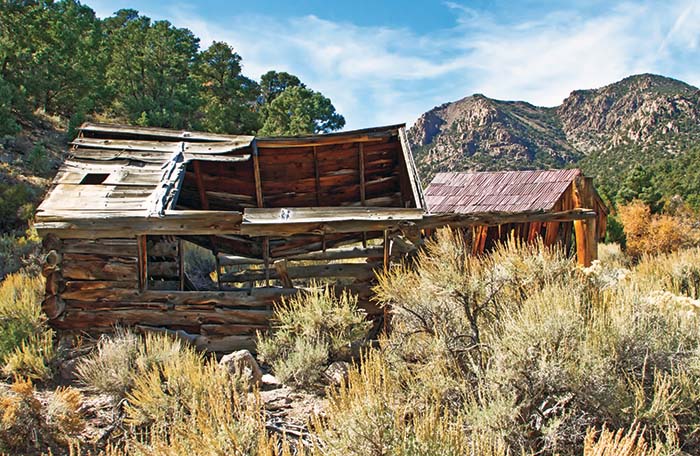
1900 – 1949
The First Half Century
The Census of 1900 showed Las Vegas to have 30 inhabitants. In 1904 the San Pedro, Los Angeles and Salt Lake Railroad Co. ran a line connecting Las Vegas to the rest of the world. Along with a depot, the station had a cafe and the town’s first casino. Prior to the coming of the railroad, travel was limited to wagons on a dirt road. The Las Vegas area actually had fewer people than Searchlight, a mining town 60 miles to the south.
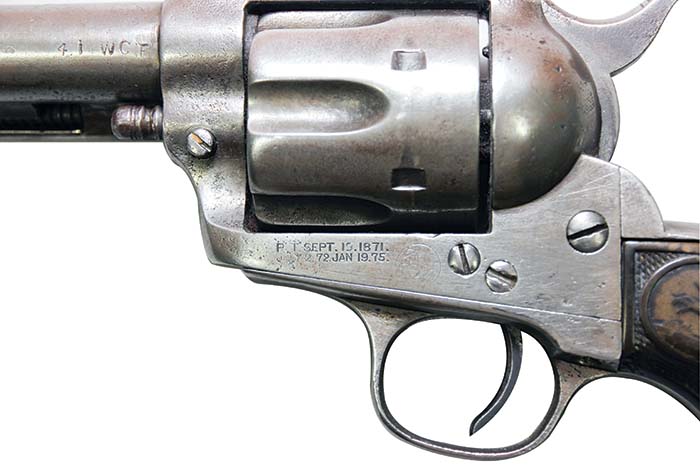
Montana Senator William Clark saw the possibilities of the Las Vegas Springs area as a stopping and watering spot on the Salt Lake City – Los Angeles rail line and he bought a large parcel of land near the Springs. He then sold 600 lots to the tune of $265,000 in 1905 and the city was born. Then, if the heat and the dust weren’t enough to keep visitors away in hordes, Nevada banned all gambling in 1909. However, railroad workers kept moving to Las Vegas, and Las Vegas was incorporated as a city March 16, 1911.
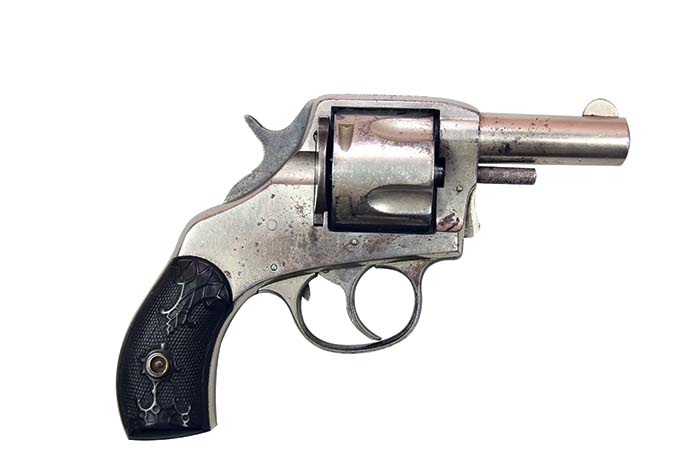
Over the next 20 years small ranches began to appear both in and around the new city. Some of them didn’t do so much farming, but were only thinly disguised brothels. Soon the town became a draw for Californian residents, especially from the Los Angeles basin. Then Hollywood discovered Las Vegas. Both actors and people in the rapidly growing entertainment business were drawn mainly to the gambling, which even though outlawed continued to flourish, the climate, and Nevada’s liberal divorce laws. Future divorcees had to live in Nevada for only six weeks before obtaining a decree.
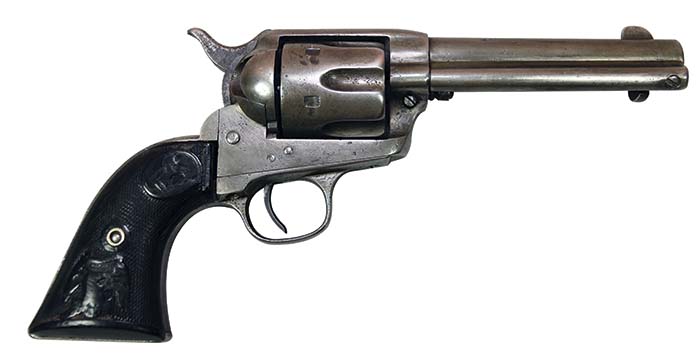
Life in Las Vegas during the formative years was a bit on the wild and wooly side and law enforcement became a top priority in Clark County beginning around 1909. (Clark County, named after William Clark, was spun off from Lincoln County Feb. 5, 1909.) The county needed a sheriff’s department and the Clark County Sheriff’s Office was established. The first sheriff appointed was Charles C. Corkhill, owner and editor of The Las Vegas Age newspaper. He had no law enforcement background and only held the position for 18 months.
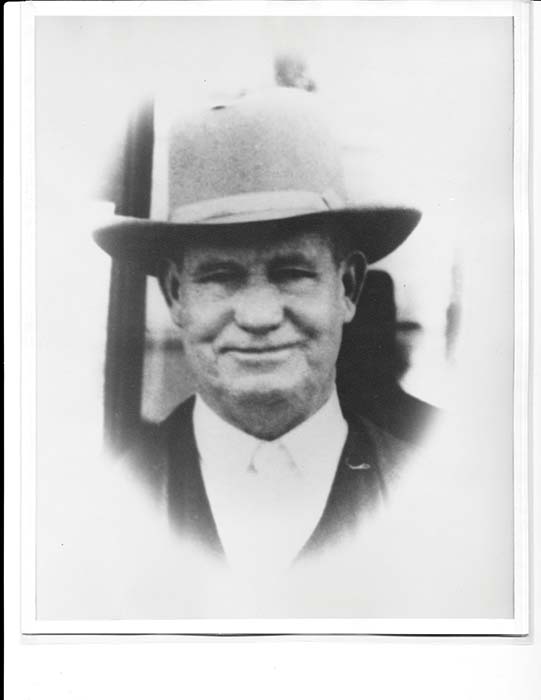
Replacing him was “Big Sam Gay.” Six foot tall and 260 pounds, he came by his nickname honestly. Born March 1, 1860 on Prince Edward Island, Canada, Sam came to Las Vegas in 1905 and became Charles Corkhill’s deputy.
Now, Sam had a slightly slanted outlook on crime and criminals. He firmly believed that all the miners and freight haulers had every right to raise hell, get drunk and generally lose money at the gambling halls. He just wanted to keep them from doing serious harm to each other, or killing their drinking companions. Big Sam came by this attitude honestly, as he was known to enjoy the taste of good whiskey and he claimed to having been instructed in the manly art of fisticuffs by none other than John L. Sullivan, the heavyweight boxing champion.
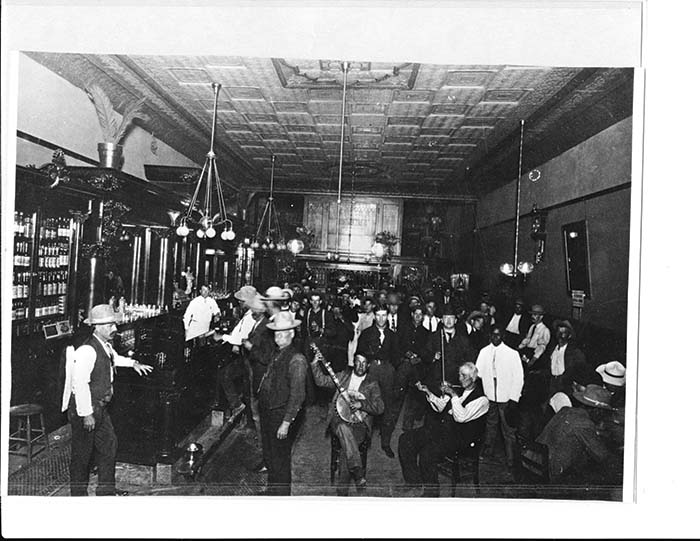
Gay was noted to prefer to settle a drunken brawl by banging the participant’s heads together. Should that not stifle the festivities, he would drag the drunks out to the bar’s hitching post, tie them there and apply a liberal application of cold water from a hose. He could settle most problems without resorting to a gun. As a matter of fact, he said many times that he preferred not to carry a gun… except for one well known situation, that is. The incident was reported in The Las Vegas Age as “Bloodless Scrap; Adam Kramer and Sam Gay Talk Politics with Rock and Gun.”
It seems as though Big Sam and a local barber, Adam Kramer, were having a somewhat heated discussion based around politics. Sam invited Kramer to step behind his barber shop and continue the discussion. Kramer opined that Sam might be amenable to changing his mind if persuaded by an outside source – like a large rock upside Sam’s head. Sam rightfully determined that he really didn’t wish to be a recipient of such largess and elected to settle the argument by a display of one of Mr. Colt’s .44 caliber revolvers. Kramer wisely decided to return said rock to its resting place in the dirt.
Though seldom wielding his firearm in the course of his work, it must be said that Sam did enjoy taking a large dose of his favorite drink, and then proceeding to shoot out street lights. One seriously drunken night Sam managed to lower the population of overhead lights on downtown Fremont Street by quite a respectable number. This show of, shall we say, “unadvised” behavior earned him a visit to the District Attorney. He did not plead, but informed the DA that “so long as I am sheriff of Clark County, I will no longer take a drink of intoxicating liquor. If I do, I will hand in my resignation.”
He stuck it out as far as is known. However, in later years he said that Prohibition, made law in 1919, helped him out. “I quit drinking it after they started making it out of old shoes,” he said. Sam Gay lived until 1932 when a massive heart attack hit him and he died in Las Vegas Hospital.
1930s
The Mob
And then came 1931 and Nevada legalized casino gambling. Clark County issued a three month gaming license to the Northern Club at 15 East Fremont. The first Casino to open on the three mile, dusty, Las Vegas Strip was the El Rancho, built by Thomas Hull in April 1941. It sported a casino, a 250 seat showroom and 63 rooms. Later, in 1946, the Flamingo was opened by a “gentleman” named Benjamin Siegel, aka Bugsy Siegel. The Mob had arrived. Well, not exactly. Back in the 1920s Jim McKay and Bill Graham, contemporaries of Chicago’s notorious Alphonse Capone, ran a casino in Reno. Later that decade, another of Al Capone’s business associates, Frank Detra, opened the Pair-O-Dice Club on Highway 91, now Las Vegas Blvd.
Siegel got his start on the West Coast in the usual way – killing his opposition and muscling into Hollywood movie unions in the late 1930s. He figured that with gambling legalized in Las Vega, he could make some serious money in southern Nevada. He and his cohort in crime, Moe Sedway, then got involved with the race wire service- Trans America Wire.
With that venture in hand, the twosome decided that the El Cortez needed some new management. After taking over that casino for a reputed sum of $600,000, Bugsy decided to build and run his own gambling hotel. So began the Flamingo. He had a partner, but the partner had a drinking and gambling problem, so goodbye to the partner (who later died of a heart attack – not lead poisoning).
Problem was, Bugsy wasn’t too good at running a casino, but he and girlfriend Virginia Hill were great at skimming money. It was reported that she took a short trip to Switzerland with $2.5 million as part of the skim.
The next problem was that Bugsy’s boss, Meyer Lansky, was aware of the skim. He considered Bugsy a friend; but finally decided that Bugsy had to go. In the evening of June 20, 1947, an unknown assailant fired nine rounds from an M1 Carbine through a window at Virginia Hill’s home. Bugsy was sitting on a couch, and there he died.
The next day David Berman and Moe Sedway walked into the Flamingo and announced that they were taking over.
The Mob then decided to get into the casino business in a big way. For the next 20 years just about every casino in Las Vegas had some sort of ties to organized crime. The Mob owners also branched out into other businesses. For example, Desert Inn CEO Moe Dalitz built homes, shopping centers and country clubs.
Many people speak of the Mob rule days as a time of safe streets, cheap casino food and less crime. Like many other tales of the Mob, time has lent an aura of fantasy to “The Good Old Days.” Unfortunately like all tales, the reality was much different. Some of the Mob that died violently over the years include Gus Greenbaum and his wife, Anthony Bracanto, Anthony Trombone, Anthony Spoliator, and Sam Giancana.
1950 – 1974
Population Growth
The onset of affordable air conditioning did a lot towards making the Las Vegas area more attractive to Clark County residents during the hot summer months. There were 30,000 home units sold in 1946. That number grew to one million by 1953. All of a sudden living in Las Vegas looked much more feasible.
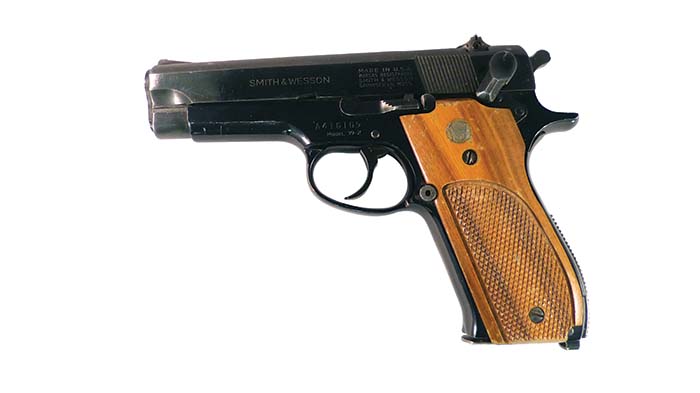
Nevada is/was not burdened with a state income tax. Back in the time period gambling was unregulated, and there was no waiting period for marriages. Plus, gambling was done with actual silver dollars.
Elvis first appeared at the Venus Room at the New Frontier in 1956. The Rat Pack came to town. Liberace put sequins on his jackets, and divorce was, if not as quick as marriage, still quicker than any other place in the USA.
In 1961 a new sheriff came to town – Ralph Lamb. He was born and raised in Alamo, NV, A small town 95 miles north of Las Vegas. Lamb joined the sheriff’s office as a deputy in 1947 but took a few years off to run his own detective agency. He ran for sheriff in 1960 and was elected and served from 1961 to 1979. He was known as “The Cowboy Sheriff” because he spent a lot of time on a horse. This established a persona that he went to great lengths to perfect.
Here’s a part of an interview he gave to the Las Vegas Review-Journal in 1999 that shows his style.
Ralph Lamb walked into the old airport on Las Vegas Blvd. and a man he had never seen before tried to kill him. “Shot at me three or four times and I wasn’t as far as from here to that door,” said the retired lawman, gesturing at a doorway perhaps 12 feet away. “And he didn’t hit me once. I hit the concrete and shot at him a couple of times and I didn’t hit him once. Then he was running away and I would have had to shoot him in the back, so I run him down, tackled him. He turned out to be just a wanted guy. He must have seen me coming in maybe saw me fix my coat to cover my gun or badge, and assumed I was coming for him.”
Lamb never actually shot anybody in a lifetime of law enforcement, he said. Gunplay wasn’t his style. Fisticuffs, calf roping and politics were. Sheriff Lamb had a huge dislike for corruption and criminal activities in general, and the Mob operation in specific. He brought down on them an immense amount of pressure, which in turn hampered their multi-million dollar day-to-day operations. He was responsible for incarcerating mobster “Handsome Johnny” Rosselli long enough to where he was never able to regain his gangster stature again. By the way, “Handsome Johnny” was found ten years later in a 55-gallon oil drum off the coast of Miami.
Las Vegas Metropolitan Police Department
Prior to July 1, 1973, there were five police agencies in Clark County; namely the Clark County Sheriff’s Department, City of Las Vegas Police Department, City of North Las Vegas Police Department, City of Henderson Police Department, and Boulder City Police Department. The cities policed their incorporated areas and the Sheriff’s Department provided police services to the unincorporated areas of the County of Clark.
Senate Bill 340 was passed and became effective on July 1, 1973 wherein the Las Vegas Police Department and the Clark County Sheriff’s Department were deactivated and the Las Vegas Metropolitan Police Department was activated to take their place. The new department (Metro) would be responsible for all police services within the city limits of the City of Las Vegas and the unincorporated areas of Clark County.
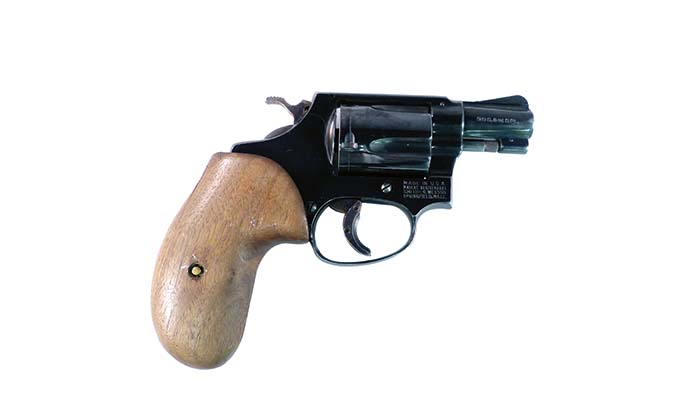
Las Vegas Metropolitan Police Department has several qualifications on what type of handgun may be carried:
- The firearm MUST be manufactured by: Beretta, Colt, Glock, Kimber, Para Ordnance, Wilson Combat, Unertl Ordnance, Heckler & Koch, Ruger, SIG Sauer, Springfield Armory, Steyr Mannlicher, or Smith and Wesson.
- The firearm MUST be chambered in either: 9mm, .40 S&W, or .45 ACP.
- The firing mechanism must be: Traditional double/single action (Beretta, H&K, Ruger, SIG Sauer pistols), single action (1911-style pistols), striker-fired or “safe-action” (i.e. Glock and Steyr “M” pistols), double-action only (i.e. Smith & Wesson 5946 pistol).
- The finish must either be blued/black or stainless steel.
- Barrel length must be at least 3.5 inches and not exceed 6 inches.
- Grips must be either a high-impact plastic or rubber (black in color), or wood; and must be designed to be used with either hand.
Photos courtesy of UNLV Special Collections, (Silverstateghosttowns.com), Historical Image Bank, Las Vegas Metropolitan Museum Association, David Condon, Clark County Museum and the Mob Museum.
All guns shown courtesy Metropolitan Police Museum Association – Lt. Dennis Larson retired and Lt. Stan Olsen retired.
| This article first appeared in Small Arms Review V19N1 (January 2015) |



